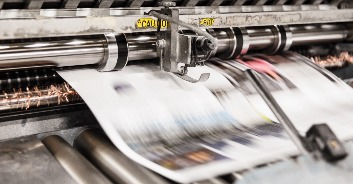How Green is your printing?
- Marcus Bowen
- Jul 1, 2022
- 3 min read
With a drive for the UK to become net zero by 2050, which means removing the same amount of carbon emissions from the air as is produced, the UK government is calling on businesses to do their bit to reduce emissions.
When it comes to print there are lots of options for businesses looking to reduce waste and boost their eco credentials by creating more eco-friendly marketing materials and business documents.
Whether you are looking for a 100% sustainable eco-inspired brochure or just venturing out with your first steps in environmentally friendly printing, here are the key things to consider when making your print greener.
· Paper choice

Your choice of paper is probably the biggest way you can make an impact. From recycled paper to tree free options, sustainable paper is becoming more and more common.
Look out for responsibly sourced paper which is created using properly managed forests, or paper which has been recycled to cut down waste. Don’t be afraid to ask questions and check what assurances you have that the paper being used is responsibly sourced.
Looking to go a step further? Treeless paper is also available using sugar cane, bamboo and even agricultural waste. 100% sustainable and biodegradable it is a good alternative to traditional paper for environmentally conscious consumers.
· Minimise waste
Check whether your supplier is recycling waste materials. What are they doing to cut down paper usage? There are lots of ways to utilise off cuts of paper these days from donating to local schools and nursery settings to recycling. Make sure that your supplier is careful not only with the items they create but the leftover off cuts as well.
· Cut down on deliveries
Bulk orders together. By using one supplier for multiple projects it means that you will only have one delivery for all of your orders cutting down on carbon emissions.
Take the time to think through and plan how and when you are going to need resources. If you are struggling, our team could provide a free audit that offers guidance on how you could get the most out of your print.
· Greener energy

Choose to work with people that use greener energy supplies. In 2015, we installed solar panels onto our roof to help use greener resources to power our site. It means that your print is powered by greener energy dramatically cutting down our carbon footprint and improving our energy usage.
When choosing a supplier look at how they power the site and whether they are using greener resources.
· Look for companies that do what they say
Look for the companies that are FSC, (Forest Stewardship Council) assured. Accreditations like this and ISO14001, the international standard for environmental management, show that a company is fully committed to supporting the environment.
· Use greener finishes
Cut down on foil finishes and opt for more eco-friendly designs. Being creative means that impressive designs don’t have to be harmful for the environment. Think about whether you could use cut outs or folded designs rather than foil and plastic-coated finishes. Clever use of shapes and colour can have just as much impact visually but an even greater positive impact on the environment.

· Designs with shelf life
Create designs that have a long shelf life. Don’t use time sensitive details or information which is likely to change. Add these sorts of details to your website. One of the best ways of helping the environment is to reduce waste. This doesn’t mean you need to cut down your print, but make sure that you are clear on its use and that it serves multiple purposes. Branded folders are a great way of creating an impactful design which can be adapted for various uses. By being clever in how you create your print you can cut down on waste and get a product that really works for you.
If you want to take it a step further how about printing on paper which is engrained with seeds so once your leaflet, clothes tag or business card is finished with it can be planted and produce beautiful flowers for your recipient. Zero waste and a beautiful product that works.
· Eco ink
When it comes to ink there are lots of ways to make greener choices. Make sure that cartridges are recycled and that where possible have low volatile organic compound or VOC ratings. VOCs are compounds of carbon which are used in traditional inks and can evaporate at room temperature adding to greenhouse gases.
There are also lots of chemical alternative inks available, LG Davis uses vegetable ink which is much more environmentally friendly
Environmentally friendly print options don’t need to be difficult. There are lots of ways to add in simple steps which can have a huge impact on the environment with lots of little changes adding up to a big difference.
If you need help working out how you can add greener measures into your print, why not speak to one of the team on 0121 430 9000.












































Comments